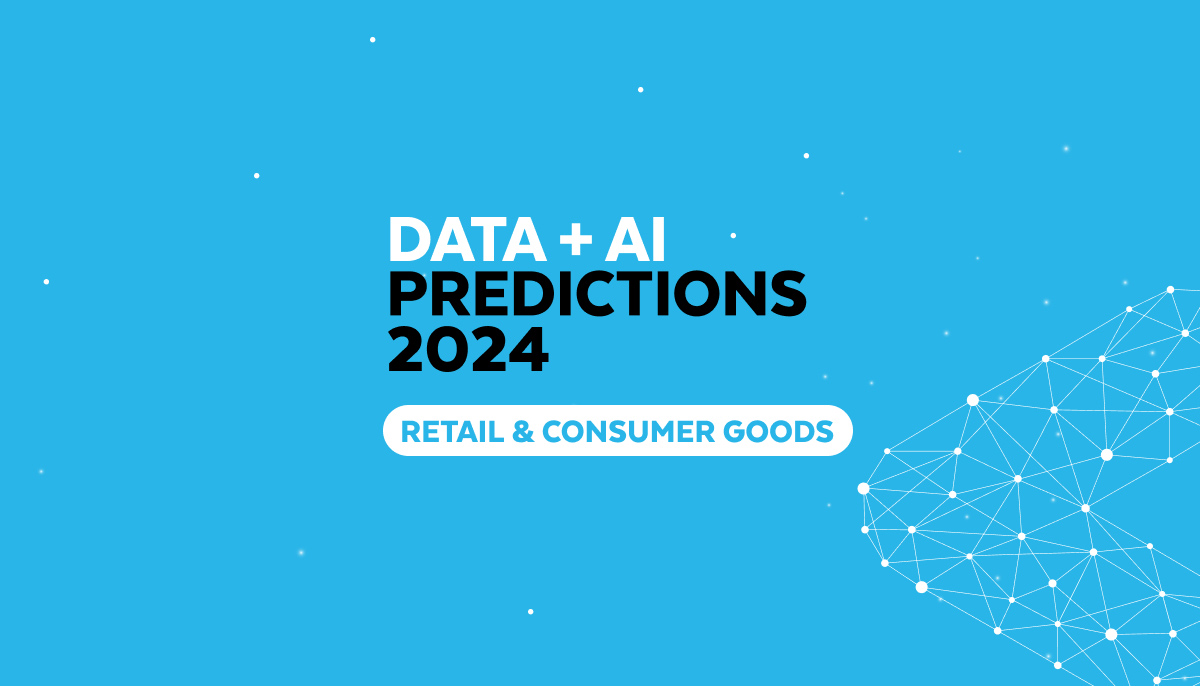Nearly every facet of society has felt the impact of AI since it burst into the mainstream in late 2022 with the public launch of ChatGPT. In 2024, the retail and consumer goods industry is expected to experience massive upheaval due to the proliferation of generative AI (gen AI) tools as well as changes in customer engagement and the general manner in which products are now sold.
As shoppers work out exactly what to think of this major step change in technology related to their everyday purchase decisions, those businesses that move quickly to incorporate AI and new data strategies into their operations will be best poised for success.
To learn more about the impact that AI and other developments are expected to have on the retail and consumer product goods (CPG) sector this year, we sat down with our Snowflake industry and technology experts. For their full insights, read the new report, Retail Data + AI Predictions 2024.
Here’s a quick look at their top three retail industry predictions for the year:
1. Gen AI experimentation will put retail companies ahead of the productivity curve
As AI adoption continues to expand, businesses will need to more clearly quantify how it impacts their success, particularly in the highly competitive retail and consumer goods segments. A large number of retail and consumer businesses are experimenting with large language models (LLMs) to leverage gen AI to improve operational productivity, and the push to monetize gen AI investments and quantify their value is gaining momentum.
AI success metrics will vary based on use cases, but some of the most important indicators will be around quantifiable time savings, improved productivity, direct cost savings and increased revenue. Additional “soft returns” will encompass better customer experience and satisfaction, more employee skills retention, and improved operational agility for the business.
“The hype of generative AI is not over, and the building of gen AI capabilities within a secure environment has just begun.”
Rosemary DeAragon, Global Industry GTM Lead, Retail and CPG, Snowflake
2. Data monetization will create new revenue streams — and they could be massive
Historically, retailers have driven profits by increasing prices or reducing costs. Both of these methods are difficult to implement — particularly the former, since it endangers customer loyalty. Today, winning retailers are also driving profits through a comparatively new third strategy: creating new revenue streams by maximizing the data insights they can generate within their business.
Retail businesses have enormous amounts of information, and since the demand for such data is only increasing, businesses that do a poor job at monetizing their data are likely to be left behind. Since large CPG companies no longer find value in investing in thousands of unproven smaller websites, apps and social media pages, they are likely to continue pouring their investments into big players’ networks.
Still, in-store customers bring the opportunity for face-to-face sales, impulse buys and cross-selling opportunities that digital merchants often lack. This means small and midsize retailers — with shoppers physically inside their four walls — can win at selling media.
The good news is, companies don’t have to sell customer data directly to turn it into revenue. Sales and category data can be aggregated, and we expect such strategies to become more prominent in 2024. Technologies such as Snowflake’s Data Cloud make it easier to safely share data directly with buyers, and ensure information can be securely shared without risk of exposing personally identifiable information (PII).
3. A strong data strategy will set industry leaders apart from followers
Organizations that develop a top-down data strategy that informs all AI operations will emerge as leaders — able to quickly adopt new technologies as they are developed and to pivot to new tactics when market conditions change. Those that build cross-functional LLMs — spanning all lines of business — will ultimately boost the data-driven intelligence of the entire enterprise.
The most successful retailers will connect their AI systems with those of strategic partners, exponentially increasing the volume of available insights and allowing for a greater depth of intelligence. They will be able to better target sales by quickly learning how customers interact with their AI-enabled experiences and tools, and then adapting those programs accordingly. It will require a strong data strategy and forward-looking leadership to succeed.
At this critical time, businesses need a platform that delivers fast time to value alongside a flexible and future-ready foundation — one that makes it easy for everyone across the organization to access all the data they need, seamlessly, while the data remains secure and easily governable.
While it’s wise to plan for the next 10 years of innovation, businesses need a platform that can deliver value today — one that can scale as data stores grow, both internally and externally. Leading businesses in the coming year will be those that implement a cloud-based data platform that addresses the unique pain points and challenges of the retail and consumer goods industry. It will be one that allows them to more fully leverage the data they already have, develop new sources of data, and collaborate with partners across the retail ecosystem — all by leveraging the powerful capabilities of generative AI and LLMs.
For more predictions and insights, get the full report, Retail Data + AI Predictions 2024.
